Line 4 Sheppard
Line 4 Sheppard is the newest and shortest subway line of the Toronto subway system, operated by the Toronto Transit Commission (TTC).[2] It opened on November 22, 2002, and has five stations along 5.5 kilometres (3.4 mi) of track, which is built entirely underground in the district of North York along Sheppard Avenue East between Yonge Street and Don Mills Road.[3] All stations are wheelchair accessible and are decorated with unique public art. The Government of Ontario has announced plans to extend the line east to Sheppard Avenue and McCowan Road in Scarborough.
| Line 4 Sheppard | ||||||||||||||||||||||||||||||||||||||||||||||||||||||||||||||||||||||||||||
|---|---|---|---|---|---|---|---|---|---|---|---|---|---|---|---|---|---|---|---|---|---|---|---|---|---|---|---|---|---|---|---|---|---|---|---|---|---|---|---|---|---|---|---|---|---|---|---|---|---|---|---|---|---|---|---|---|---|---|---|---|---|---|---|---|---|---|---|---|---|---|---|---|---|---|---|---|
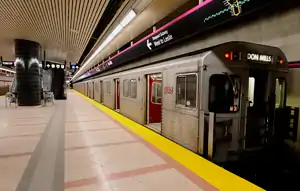 Platform level of Don Mills station | ||||||||||||||||||||||||||||||||||||||||||||||||||||||||||||||||||||||||||||
| Overview | ||||||||||||||||||||||||||||||||||||||||||||||||||||||||||||||||||||||||||||
| Owner | Toronto Transit Commission | |||||||||||||||||||||||||||||||||||||||||||||||||||||||||||||||||||||||||||
| Locale | Toronto, Ontario, Canada | |||||||||||||||||||||||||||||||||||||||||||||||||||||||||||||||||||||||||||
| Termini | Sheppard–Yonge Don Mills | |||||||||||||||||||||||||||||||||||||||||||||||||||||||||||||||||||||||||||
| Stations | 5 | |||||||||||||||||||||||||||||||||||||||||||||||||||||||||||||||||||||||||||
| Website | www | |||||||||||||||||||||||||||||||||||||||||||||||||||||||||||||||||||||||||||
| Service | ||||||||||||||||||||||||||||||||||||||||||||||||||||||||||||||||||||||||||||
| Type | Rapid transit | |||||||||||||||||||||||||||||||||||||||||||||||||||||||||||||||||||||||||||
| System | Toronto subway | |||||||||||||||||||||||||||||||||||||||||||||||||||||||||||||||||||||||||||
| Operator(s) | Toronto Transit Commission | |||||||||||||||||||||||||||||||||||||||||||||||||||||||||||||||||||||||||||
| Rolling stock | Toronto Rocket | |||||||||||||||||||||||||||||||||||||||||||||||||||||||||||||||||||||||||||
| Daily ridership | 50,150 (2018 avg. weekday)[1] | |||||||||||||||||||||||||||||||||||||||||||||||||||||||||||||||||||||||||||
| History | ||||||||||||||||||||||||||||||||||||||||||||||||||||||||||||||||||||||||||||
| Opened | November 22, 2002 | |||||||||||||||||||||||||||||||||||||||||||||||||||||||||||||||||||||||||||
| Technical | ||||||||||||||||||||||||||||||||||||||||||||||||||||||||||||||||||||||||||||
| Line length | 5.5 km (3.4 mi) | |||||||||||||||||||||||||||||||||||||||||||||||||||||||||||||||||||||||||||
| Track gauge | 4 ft 10 7⁄8 in (1,495 mm) Toronto-gauge railways | |||||||||||||||||||||||||||||||||||||||||||||||||||||||||||||||||||||||||||
| Electrification | Third rail, 600 V DC | |||||||||||||||||||||||||||||||||||||||||||||||||||||||||||||||||||||||||||
| Signalling | Automatic block signaling | |||||||||||||||||||||||||||||||||||||||||||||||||||||||||||||||||||||||||||
| ||||||||||||||||||||||||||||||||||||||||||||||||||||||||||||||||||||||||||||
Name
When the subway opened, it was given the name "Sheppard line" and the official name 4 Sheppard Subway.[4] In October 2013, the TTC announced plans to give the lines official numbers to help riders and visitors navigate the system. The Sheppard line was renamed "Line 4 Sheppard" and new signage reflecting this began being gradually implemented in March 2014.[5][6][7] The Toronto Rocket trains also use the numerical system for interchange station announcements, such as announcing "Change for Line 1" when the trains arrive at Sheppard–Yonge station.
History
Origins
The TTC proposed the Sheppard line as part of the Network 2011 transportation plan, unveiled in 1985, which called for a line from Yonge Street to Victoria Park Avenue.[8] The plan was approved by Metropolitan Toronto, but funding was delayed by the provincial government of David Peterson's Liberal Party.
In 1993, the governing New Democratic Party (NDP) under Bob Rae proposed provincial funding for four subway/LRT projects for the TTC. Included in these four proposals were plans to build new subway lines along Eglinton and Sheppard Avenues and work was begun on both projects.[9] The NDP was defeated in the 1995 provincial election and the Progressive Conservatives under Mike Harris were elected. Harris cancelled the Eglinton subway in York but continued work on the Sheppard line.
Funding for the Sheppard line was initially rejected by city council. However, after a number of votes on different alterations to the project (including only building the subway line as far as Leslie Street), the proposal to build the Sheppard line tunnels only, without tracks, was passed by a narrow margin. After this vote passed city council, a re-vote was taken on the entire Sheppard line project to Don Mills, which then passed by a very narrow margin. James Bow, a Toronto transit reporter, documented that the political clout of North York mayor Mel Lastman (he was later elected mayor of the amalgamated City of Toronto in 1998) was crucial to the Sheppard line proposal being implemented.[10] Councillor Joe Pantalone strongly supported the line, arguing it was a matter of civic equity and that the suburbs deserved good transit, which would – in his opinion – bring development.[11] David L. Gunn, who was general manager of the TTC, opposed the Sheppard line, saying that it "made no sense to build an expensive new subway when the existing system was strapped for cash to make basic repairs" and "if the city wanted to expand transit, it would be better to do it downtown, easing congestion in the busiest parts of the system".[11]
Completion and opening
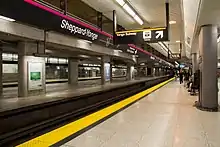
The Sheppard line was opened on November 22, 2002. It was the city's first new subway line since the opening of the Bloor–Danforth line in 1966.[12] It remained the newest subway infrastructure in Toronto for 15 years until the opening of the Toronto–York Spadina Subway Extension in 2017. It is shorter than had been planned, running from Yonge Street (at the former Sheppard station, renamed Sheppard–Yonge when the Sheppard line opened) east to Don Mills Road rather than further west to Downsview station and southeast to Scarborough Centre station. Downsview (renamed Sheppard West in May 2017) had been built in 1996, ostensibly with the intention of being the western terminus of the Sheppard line prior to the latter's truncation.
The Sheppard line cost just under C$1 billion and took eight years to build. It is the first subway line in Canada that had plain tunnel sections built entirely by tunnel boring machine. The Sheppard line is the only subway line in Toronto that does not have any open sections. All stations on the line were constructed using the cut-and-cover method, with the expansion of Sheppard station having required an S-shaped diversion of Yonge Street during construction. Just east of Leslie station, there is an enclosed bridge over the east branch of the Don River.
It was the first line to have accessible elevators at every station.[12] The automated system to announce each station was installed in January 2006.
Its stations were built to accommodate the TTC's standard subway trains of six 23-metre (75 ft) cars, but part of each platform has been blocked off since only four-car trains are needed to carry the amount of traffic on the line. The line was designed so that it can be extended at both ends, allowing for the construction of westward and eastward branches that had been planned. Likewise, the Sheppard line level of Sheppard–Yonge station was constructed with a roughed-in Spanish solution platform layout in anticipation of increased ridership.
Platform screen doors were proposed for the Sheppard line. Installed at the edge of the platforms, platform screen doors would have aligned themselves with the subway-car doors when trains were in station for safety and suicide prevention. The proposed system was dropped because of its cost.
Rolling stock
From its opening in November 2002 to May 2016, the line was operated solely with four-car T1 subway trains, with two staff members operating the trains – one driver and one guard who operated the doors. On May 30, 2016, new four-car Toronto Rocket (TR) subway trains were introduced on this line. They replaced the older T1 subway trains, which were moved to Line 2 Bloor–Danforth. The TRs are based on Bombardier Transportation's Movia-styled train sets and are the first TTC trains which have no separators between the cars. This allows passengers to walk freely from one end to the other, unlike Toronto's previous subway cars. The change to TR trains was necessary because Line 4 trains are based in Davisville Yard, which is accessed via Line 1 Yonge–University. That line is being converted to operate using an automatic train control system, which was scheduled to go online in phases between 2017 and 2020, and the T1 trains are not compatible with this system.[13] Since October 9, 2016, Line 4 is serviced entirely by four-car TR trains, which are operated by one staff member who both drives the train and operates the doors (similar to the model already in place on Line 3 Scarborough).[14]
Residential development
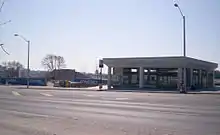
From its opening in 2002 to 2014, the Sheppard line spurred over $1 billion of construction of new housing,[15] including several high-rise condominium towers, along its route as transit-oriented developments. Since 2000, condominium towers have been built around all five stations on the line, with most of the new developments being centred around Bayview and Bessarion.[11] The Daniels Corporation built a six-tower development, called NY Towers, north of Highway 401 between Bayview and Bessarion; Arc Condominiums on the northeast corner of Bayview/Sheppard; and terraced condos just east of their NY Towers. Shane Baghai built a multi-tower development in the area.
In 2007, the Leslie and Bessarion stations were the least used stations in the system;[16] in 2015, four of twenty planned buildings of Concord Adex Investments' new condominium complex, Concord Park Place, located between these two stations, had been completed.[17] The complex is being developed on the site of a former Canadian Tire warehouse/distribution centre, though Canadian Tire retains a retail location there. There is also development around Swedish furniture chain IKEA in the immediate area.
Ridership
From late 2002 to 2011, ridership on the Sheppard subway rose from about 10.7 million riders annually to a peak of 15.9 million. However, in 2014, ridership on the line dropped by five percent to 15.1 million. (The TTC does not consider that a statistically significant decline.)[18]
The following list shows the typical number of customer-trips made on the Sheppard subway on an average weekday:
- 2007–2008: 45,860[19]
- 2008–2009: 45,410[20]
- 2009–2010: 47,700[21]
- 2010–2011: 49,150[22]
- 2011–2012: 50,410[23]
- 2012–2013: 49,440[24]
- 2014: 47,680[25]
- 2015: 49,070[26]
- 2016: 47,780[27]
- 2018: 50,150[1]
Note: 2017 figures are unavailable.
Station art
Line 4 features artwork in each station, such as the scenic mural at Sheppard–Yonge station, Bayview station's trompe-l'œil and Leslie station's individual tiles, each containing the words "Sheppard & Leslie".
Criticism
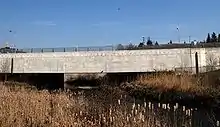
The line has been criticized as a "subway to nowhere", a "stubway", or a "white elephant".[28] In 2018, the total ridership on the Sheppard subway line was approximately 50,000 per average weekday, similar to a few of the TTC's busiest streetcar and bus routes, though these routes are generally much longer than Sheppard's 5.5-kilometre (3.4 mi) length.[1] The Sheppard line feeds passengers into the Yonge segment of Line 1 Yonge–University. During the City of Toronto's 2008 budget crisis, the TTC considered shutting the line down on weekends or entirely.[29]
Jarrett Walker, a transportation consultant and the author of the book Human Transit, says "Sheppard's technology makes it both expensive to abandon and expensive to extend; that's the trap."[30]
Councillor Josh Colle, who chaired the TTC from December 2014 to December 2018, said in May 2015 that, given the existing Sheppard subway's performance, he could rationalize spending more money to expand it east from Don Mills or west from Sheppard–Yonge. He estimated that the Sheppard subway receives a subsidy of more than $10 per ride.[18]
According to the Metro commuter newspaper, between the opening of the Sheppard line in November 2002 and December 2014, there was over $1 billion in development along that corridor, much of it in the vicinity of Bayview, Bessarion and Don Mills stations. The latter station has a density suitable for a subway at 10,182 people per square kilometre. Yet, despite this, a majority of commuters along the Sheppard subway drive to work rather than using public transit.[15][31] In 2016, according to Royson James of the Toronto Star, residents in the area commuted to jobs throughout the Greater Toronto Area by automobile rather than taking public transit. James stated that subways are designed for corridors with four to eight times the ridership along Sheppard.[32]
Future expansion
Several informal proposals have been made to extend the line in both directions. The original proposal for the Sheppard line was for a major subway line running from Sheppard West station on the University portion of Line 1 to Scarborough Centre station. Instead, funding was only approved for a truncated line with the possibility of several phased expansions.
As of 2020, neither the eastward nor westward extension projects are active. However, the eastward extension has provincial government support but no funding nor a target date for completion.[33]
Eastward extension
The TTC considered the eastward extension of the Sheppard line to Scarborough Centre station as one of its top priorities for rapid-transit expansion, which would expand rapid transit in Scarborough for the first time since the completion of Line 3 Scarborough. The eastward extension would include new stations at Consumers Road, Victoria Park Avenue, Warden Avenue, Kennedy Road, Agincourt GO Station, and Progress Avenue, terminating at the existing Scarborough Centre Station on Line 3 Scarborough. The expansion proposal also included the possible addition of an infill station at Willowdale Avenue between Sheppard–Yonge and Bayview stations on the existing portion of the line.
In 2015, the TTC estimated that a Sheppard subway to Scarborough Centre would have 7,800 riders per hour while 10,000 per hour is the minimum number of riders per hour considered appropriate for a subway. The maximum capacity of the subway is about 30,000 riders per hour, approximately the load the Yonge portion of Line 1 carries in the morning rush.[18]
In April 2019, the provincial government under Premier Doug Ford announced that it supported an eastward extension of Line 4, but there was not yet a promise of funding nor a proposed target date for completion. The province revised the proposed route to terminate and meet a proposed extension of Line 2 Bloor–Danforth at Sheppard Avenue East and McCowan Road instead of at Scarborough Town Centre.[33]

Westward extension
A separate 4.5-kilometre (2.8 mi) westward extension to Sheppard West station proposed the creation of stations at Senlac Road, Bathurst Street, and Faywood Boulevard. Lower population density made this expansion a much lower priority than the eastward one, as the minimal increase in ridership was insufficient to justify the costs. The approval of the Spadina subway extension to the Vaughan Metropolitan Centre in York Region renewed interest in this phase, as a subway connection between Sheppard West and Sheppard–Yonge stations would significantly lower commuting times for York University students. The tunnel from Sheppard–Yonge to Welbeck Road (east of Senlac Road) was built for train storage at the time of original construction.
In 2013, this extension was listed as being considered as an "unfunded future rapid transit project" in the City of Toronto's "Feeling Congested?" report.[34] As of April 2019, the westward extension had neither provincial government support nor funding.[33]

Transit City
In March 2007, the City of Toronto and the TTC released the Transit City proposal to begin a new round of transit expansion using light rail technology on dedicated rights-of-way instead of subway technology. Under this plan, the Sheppard East subway extension had been replaced by a light rail line running from Don Mills Station along Sheppard Avenue East to Meadowvale Road, where it would meet the northern terminus of an extended Line 3 Scarborough. Under this proposal, there would be no direct connection between North York City Centre and Scarborough City Centre.
In 2009, a westward extension was again considered by the TTC to link the line to Wilson Subway Yard. It was immediately dismissed due to cost.[35]
Rob Ford era
As a result of the election of Rob Ford as mayor of Toronto in 2010, the western extension of the Sheppard subway to Sheppard West Station and the eastern extension to Scarborough Centre were considered a priority again.[36] He indicated in a December 2010 interview with The Globe and Mail newspaper that all other transit projects would come second to completing the Sheppard line, stating "I'm just focusing on doing the Sheppard subway underground."[37]
On March 31, 2011, Rob Ford announced that the proposed Sheppard East LRT line would be replaced by western and eastern extensions for the Sheppard line so that the completed line would run from Sheppard West station to Scarborough Centre. The Ontario government approved this plan, which was estimated to cost $4.2 billion. The City of Toronto would assume complete financial responsibility for the project, which was proposed to be funded through a public–private partnership, as well as through the use of surplus funds from the proposed Eglinton Crosstown line, if there were any. Massive redevelopment along the route would be needed to generate these funds, as the then-current population density and projected ridership was too low to support the cost of the expansion by itself.[38][39]
In 2011, Metrolinx estimated that the westward extension to Sheppard West would be 5.45 km (3.39 mi) long, add two stations, and cost $1.48 billion. The Sheppard East extension would be 8 km (5.0 mi) long, add seven stations, and cost $2.75 billion.[40]
Gordon Chong, head of the TTC agency tasked with analyzing the new subway plans at the time, said it was possible that no new transit development would occur along Sheppard.[41]
Stintz's alternative
On January 23, 2012, TTC chair Karen Stintz suggested a plan to extend the line two stops eastwards funded by making the eastern portion of Line 5 Eglinton at street level.[42] This motion was defeated by the TTC board. She then got 24 councillors (a majority) to sign a petition calling for a special council meeting for February 8 of that year.
In the meeting, council voted to build the Eglinton project according to the original Transit City plan (partly underground and partly at grade), build an at-grade Finch LRT, and to appoint a panel to recommend whether to pursue the eastward extension of the Sheppard subway or construct the Sheppard East LRT instead. The panel reported back to council on March 31, 2012.[43] At this council meeting, council approved light rail rather than a subway extension for Sheppard.[44] On April 26 of that year, the motion to build the LRT was announced by the Minister of Transportation after being approved unanimously by Metrolinx.[45] The plan still needs to be approved by Ontario's cabinet, though on June 29, 2012, the Board of Directors of Metrolinx unanimously approved the same motion approved by Metrolinx in April.[46]
Tory era and beyond
During the 2014 Toronto mayoral election, incumbent mayor Rob Ford (and his brother Doug Ford, after the prior's withdrawal) were the only major candidates who supported completing the Sheppard line east to McCowan (phase-one project) and west to Sheppard West station (phase-two project).[47] John Tory, who won the election, did not include anything on the Sheppard corridor in his maps; instead, he favoured SmartTrack. However, he did say that he would proceed with the LRT, although the project would not be a priority for him.[48]
On April 27, 2015, Steven Del Duca, the Ontario Minister of Transportation, said that the LRT project would not start until at least 2021.[49] In July 2016, Toronto City Council approved a one-stop subway extension on Line 2 Bloor–Danforth to Scarborough Centre Station. During this vote, city council also approved putting an extension of Line 4 into Scarborough back into consideration.[50]
In April 2019, Doug Ford, who had since become Premier of Ontario after the 2018 provincial election, unveiled a plan for new subways in Toronto, including the new Ontario Line to replace the proposed Relief Line, an extension of Line 1 to Richmond Hill, an eastward extension of Line 2 with new stations, a westward extension of Line 5 Eglinton to Toronto Pearson International Airport and an extension of Line 4 Sheppard east to McCowan Avenue, where it would intersect with the Line 2 extension. However, money was not set aside in the government's budget for the extension.[51]
Service frequency
The frequency for this line is 5–6 minutes at all times during scheduled hours.
On September 4, 2005, an overnight service on Sheppard Avenue East was introduced. The 385 Sheppard East Blue Night bus route provides late-night service when the subway is not in operation with the frequency of 30 minutes. This service terminates at Sheppard–Yonge station and follows Sheppard Avenue to Meadowvale.
References
- "Toronto Transit Commission Subway ridership, 2018" (PDF). Toronto Transit Commission. Retrieved February 5, 2019.
- "Subway". Schedules & Maps. Toronto Transit Commission. Retrieved February 3, 2017.
Line 4 Sheppard has five stations
- "Toronto Transit Commission – History". City of Toronto. Retrieved November 22, 2007.
- "TTC Subway".
- "TTC considers numbering subway lines". October 23, 2013.
- "TTC tests new numerical signage system".
- "New TTC Signage at Eglinton Station".
- Michael Smith. "$2.7 Billion Metro transit plan called affordable." Toronto Star. May 29, 1985. pg. A1
- Royson James. "Deciding which train to take." Toronto Star." March 8, 1994. pg. A15
- "The Sheppard Subway – Transit Toronto – Content".
- Morrow, Adrian (November 16, 2012). "Lessons from Toronto's Sheppard subway line". The Globe and Mail. Archived from the original on April 30, 2017. Retrieved May 1, 2018.
- Van Bastelaer, Sophie (November 19, 2016). "November 22, 2002: The Sheppard Subway Line opens its doors". Toronto Star.
- "Sheppard subway line gets new Toronto Rocket trains". CBC News. May 30, 2016. Archived from the original on October 4, 2017. Retrieved May 1, 2018.
- Fox, Chris (September 27, 2016). "TTC switching to single-operator model for Line 4 subway as of Oct. 9". CP24. Archived from the original on September 27, 2016. Retrieved June 20, 2017.
- Luke Simcoe (December 4, 2014). "Toronto on Track: Is the Sheppard subway line going nowhere?". Metro News. Archived from the original on July 26, 2016. Retrieved December 4, 2014.
- Tossell, Ivor (November 24, 2007). "Still a subway to nowhere?". Toronto Star. Retrieved February 10, 2017.
- McDowell, Adam (November 9, 2012). "Sheppard subway gets moving". National Post. Retrieved February 10, 2017.
- Tess Kalinowski (May 18, 2015). "Could the Finch LRT reshape the Sheppard transit debate?". The Toronto Star. Retrieved May 19, 2015.
- ""Toronto Transit Commission Subway ridership 2007–2008"" (PDF). Toronto Transit Commission.
- ""Toronto Transit Commission Subway ridership 2008–2009"" (PDF).
- ""Toronto Transit Commission Subway ridership 2009–2010"" (PDF).
- ""Toronto Transit Commission Subway ridership 2010–2011"" (PDF).
- ""Toronto Transit Commission Subway ridership 2011–2012"" (PDF).
- ""Toronto Transit Commission Subway ridership 2012–2013"" (PDF).
- "Toronto Transit Commission Subway ridership, 2014" (PDF). TTC. Retrieved November 18, 2017.
- "Toronto Transit Commission Subway ridership, 2015" (PDF). TTC. Retrieved November 18, 2017.
- "Toronto Transit Commission Subway ridership, 2016" (PDF). TTC. Retrieved August 10, 2018.
- "Stop the Sheppard LRT" Business Group Says. National Post, 2009 03 06.
- Lewington, Jennifer; Gray, Jeff (July 20, 2007). "Toronto threatens to shut Sheppard subway". The Globe and Mail. Toronto.
- Morrow, Adrian. "Lessons from Toronto's Sheppard suwbay line". Retrieved March 23, 2013.
- Matt Elliott (December 5, 2014). "Sheppard subway is a costly cautionary tale Toronto risks repeating". Metro News. Archived from the original on March 19, 2016. Retrieved December 5, 2014.
- Royson James (March 2, 2016). "Subways we already have are doomed by built-in flaws: James". Toronto Star. Retrieved March 2, 2016.
- "What you need to know about Doug Ford's contentious plan for transit in the GTA". CBC News. Canadian Broadcasting Corporation. April 10, 2019. Retrieved December 21, 2019.
- "Toronto Feeling Congested? report" (PDF).
- "TTC Report December 16 2009" (PDF).
- Kalinowski, Tess; Rider, David (December 2, 2010). "'War on the car is over': Ford moves transit underground". The Star. Toronto.
- "Search". The Globe and Mail. Toronto. December 21, 2010.
- "Toronto Mayor Rob Ford's transit plan wins provincial approval" By John Lorinc and Adrian Morrow, The Globe and Mail, March 30, 2011
- "Funding questions linger after new transit plan announced" By Natalie Alcoba, National Post. March 31, 2011
- "Metrolinx / Toronto Transit Plan" Metrolinx. April 28, 2011
- Granatstein, Rob. "Rob Ford's Sheppard hole: Granatstein". Toronto Sun. Retrieved April 4, 2011.
- "Save money on Eglinton LRT to extend Sheppard subway, TTC chair suggests".
- Kalinowski, Tess (February 9, 2012). "Special transit meeting: Mayor Rob Ford dismisses council's vote against his subway plan". Toronto Star. Retrieved February 9, 2012.
- Kalinowski, Tess; Rider, David (March 22, 2012). "Rob Ford's subway dream dead as Toronto council votes 24–19 for LRT". Toronto Star. Toronto.
- "Minister's Statement On Toronto Transit Projects".
- "More Transit for Toronto | Crosstown".
- "Rob Ford unveils subway-heavy transit plan". CBC News. September 3, 2014. Retrieved June 12, 2015.
- Dale, Daniel (August 25, 2014). "Finch, Sheppard LRTs are election 'hot potatoes' again". Toronto Star. Retrieved June 12, 2015.
- Kalinowski, Tess (April 27, 2015). "Finch LRT to be complete in 2021, before Sheppard breaks ground". Toronto Star. Retrieved June 12, 2015.
- Moore, Oliver (July 13, 2016). "Toronto City Council approves planning for raft of transit projects". The Globe and Mail. Retrieved April 15, 2017.
- Westoll, Nick (April 11, 2019). "Ontario budget 2019: No money for Sheppard line extension, new bridges on Toronto relief line". Global News. Retrieved August 15, 2019.
External links
 Media related to Line 4 Sheppard at Wikimedia Commons
Media related to Line 4 Sheppard at Wikimedia Commons- Transit Toronto – The Sheppard subway
- Rapid Transit Expansion Study (Toronto Transit Commission, 2001). (PDF, 2.6 MB)
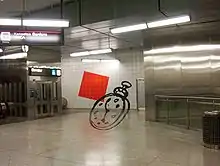


_(14918534190).jpg.webp)